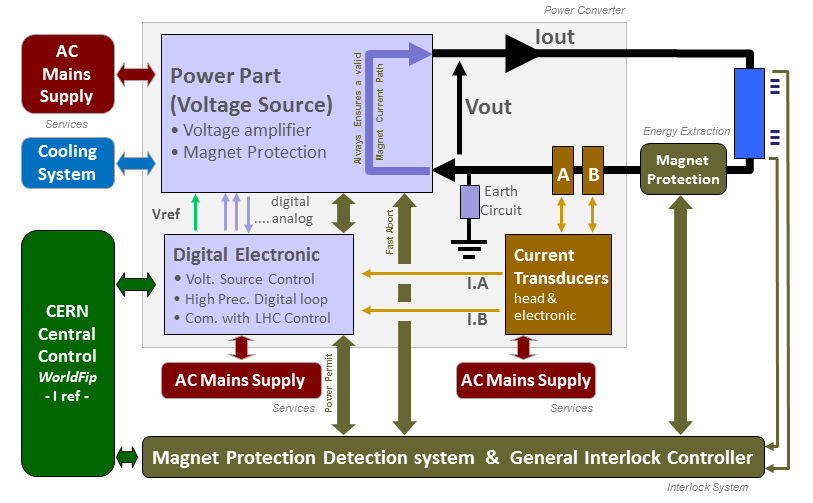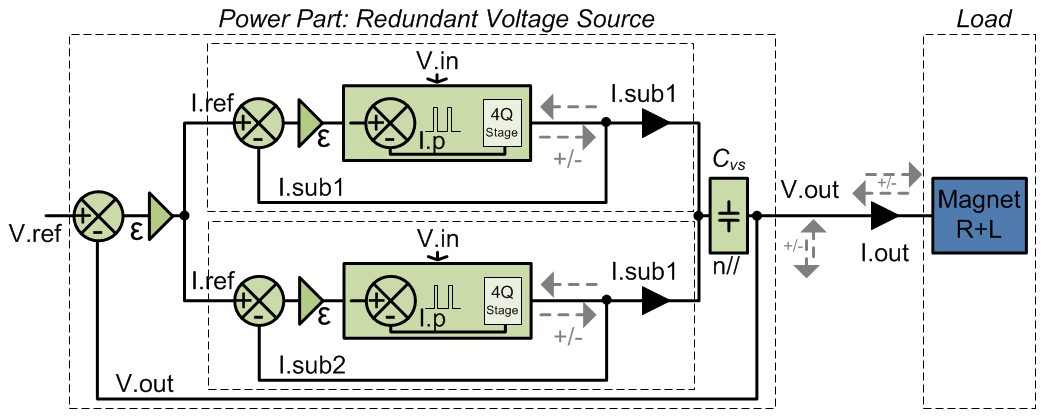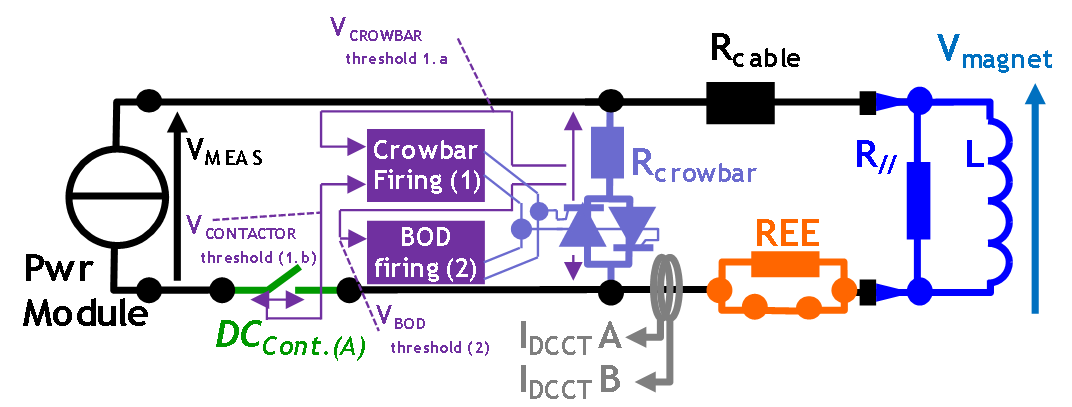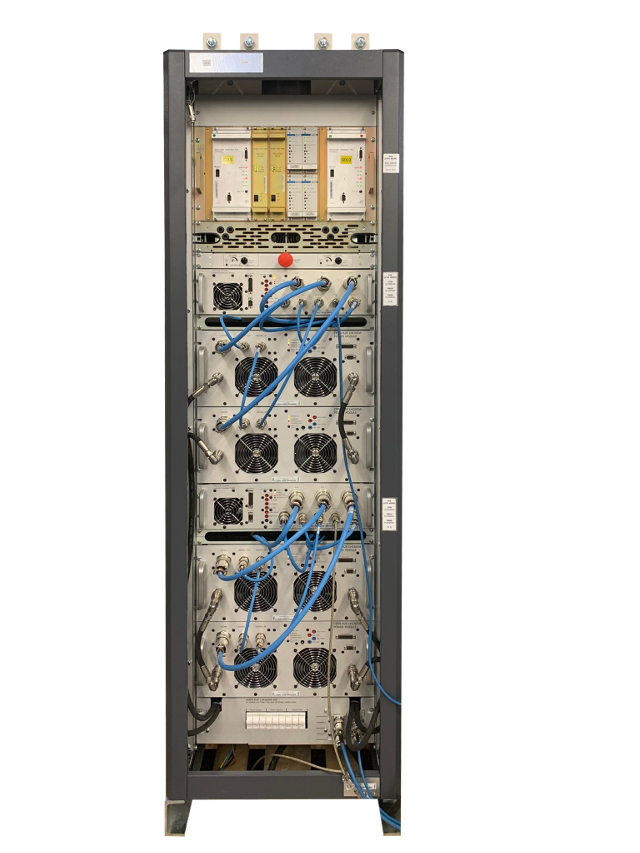|
RPMBD / R2E-LHC600A-10V |

|
 |
|
 |
|
 |
CERN
|
SY
|
SY-EPC
|
EDMS
|
PROJECTS
|
ODF
/
OOXML
|
|
CERN
|
SY
|
SY-EPC
|
EDMS
|
PROJECTS
|
ODF
/
OOXML
|

|
|
|
||||||||||||||||||||||||||||||||||||||||||||||||||||||||||||||||||||||||||||||||||||||||||||||||||||||||||||||
| Power In | 3 ~ 230V/32A |
| Power Out | +/- 600A +/-10V |
| Converter Type | 4 Quadrant |
| Control type | FGCLite / WorldFip |
| Current Accuracy | 10 ppm@ 30 mn |
| 50 ppm@ 24 h | |
| 500 ppm@ 1 year | |
| (1 ppm=0.6mA) |
 Involved Peoples
Involved Peoples
 Raul HERRERO
Raul HERRERO
|
Project Owner |
 Raul BIANCHI
Raul BIANCHI
|
Design, Integration (> 2013-08) |
 Maxime SARDANO
Maxime SARDANO
|
Design, Integration (≤ 2017) |
 Benoit FAVRE
Benoit FAVRE
|
Design, Integration (≤ 2014) |
 Power Converter Architecture
Power Converter Architecture
This Power Converter is used in LHC Machine to power superconductive magnets. It is located in the LHC underground installation, close to the loads to limit cable losses in the underground installation.
Different parts were designed and produced separately, Power Converter being finally integrated in a housing rack, with 3 main parts:
- High Precision Current sensors: DCCTs, able to measure DC current at the required precision.
- Power Part: Power Rack and its removable Power Module
- A Digital Controller (FGC) using WorldFip bus in charge of:
- The high level control from and to the Cern Control Room
- The high precision digital current loop
- Collecting and reporting all status, faults, and measurements from all the different parts to the remote services, for diagnostic and operation purposes.

Power Converter simplified Architecture .ppt
 Power Part
Power Part
A medium current switch mode power converter, designed for powering of superconducting loads requiring positive or negative current and positive or negative voltage control (4 quadrants). Constructed from a modular architecture composed of 2x [+/-400A +10V] power modules (active redundancy), the system can most of the time provide required current to the load since often less than |400A|, even with 1 Power Module only.
Primary use is in LHC particle accelerator irradiated locations (redundancy and Radiation tolerant). The converter is water cooled, and is thus ideally suited to situations where air losses must be carefully managed. Designed for underground operation, extensive remote diagnostics have been foreseen to allow efficient monitoring and fault diagnostics without requiring being present locally.
Power part is identified as a 4 quadrant voltage source, even if an internal current source control is required to adequately share output current between power modules.
| Power In | 3 ~ 230V/16A |
| Power Out | +/- 600A +/-10V |
| Cooling type | Water Cooling (+ forced air ventilation) |
| Nominal Water Condition [2x 600A modules installed] → 4.6 l/min @ 3.0 bars of Differential Pressure Drop. * | |
| Nominal Water Condition [1x 600A module installed] → 3 l/min @ 3.0 bars of Differential Pressure Drop. * | |
| Rack Water Layout, and its typical water pressure drop. | |
| Converter Weight | Bare Rack ................ 180 kg (Power Modules and full equipped electronic chassis excluded) |
| Power Module ........... 55 kg | |
| Crowbar Module ....... 25 kg | |
| Electronic Chassis .... 11 kg (Fan Tray + Chassis + 2x FGCs + 2x PSUs + 4 DCCT electronics + AC-DC) |

[+/-400A +/-10V] Power Module simplified Architecture / Topology Power Part .vsd
Power Module is actually a high frequency fully bidirectionnal (+/-400A +/-10V) current source (7-8kHz) controlled by a 1kHz bandwidth voltage loop. One can notice that Power Module is actually a current cource in its structure, even if voltage source capacitors are located in this block for mechanical reasons. Representation below gives a symbolic structure of the power converter, clarifying the cascade loops. The multiplication of rectifier stages in each output module gives the following advantages: easier design of magnetic parts, lower rating fuse (lower losses) to protect whole Power Converter being short-circuited by a faulty secondary (fuse would immediately blow in case one of the schottky dies, giving the possibility to the whole power converter to reconfigure the current level in other current sources to maintain required voltage level).

[+/-400A +/-10V] Voltage Source simplified Architecture / Topology .vsd
Redundance operation relies mainly on [+/-400A +/-10V] inner current source reactivity, and strongly depends of the output current level (400A limit), so that load output current is not impacted by the loss of one sub. Of course a sudden short at the level of the output stage of a sub converter will lead to a converter global fault stop.
![]() No fault
-
No fault
-
![]() Sub Fault Transition
-
Sub Fault Transition
-
![]() Sub Fault state
Sub Fault state
Power converter redundance
 Control Part
Control Part
Control & regulation principles are summarized in a detailled schematics representating only the part involved in the output current regulation scheme.
Control & regulation principles are summarized in a detailled schematics representating only the part involved in the output current regulation scheme.

Regulation Control simplified schematic .vsd
High precision current control loop is managed by the digital controller called FGC (Function Generator Controller). This unit includes a high precision Sigma Delta Analog to Digital Converter which digitalize the analog current measurement coming from 2 DCCTs (DC current Transducer). Precision is then directly relying on sensor precision: DCCT, the ADCs, and the algorithm being used for the regulation loop. Voltage source is then used as a power amplifier, powering the load through a high bandwidth voltage loop (>500Hz).
 Magnet Protection
Magnet Protection
Power Converter is part of magnet protection scheme, even if not directly fully responsible of the monitoring and diagnostic of the superconductive magnet status. Dedicated systems QPS (Quench Protection System) + PIC (Power Interlock Controller) can interlock Power Converter if magnet safety requires it.
Power Converter is then expected to:
- Always ensure that external protection system can stop the Power Converter through a safe signal called Fast Abort. This redundant signal uses 2 paths to interlock and stop the converter and its redundancy is checked each time it acts. It directly acts on AC and DC Contactor bobbin, ensuring their opening as required.
- Stop powering the load in safe way (handling the magnet energy even when stopping, through dedicated system called crowbar). This active system combined with the presence of DC-Contactors in the rack provide a safe resistive discharge path for magnet current (energy).
- Monitor Earth current of the total circuit: converter + load (magnet and its DC cables), and take the right action if threshold reached.
- Crowbar
The system is based on a 50 mOhms Power Resistance series back-to-back thyristors being fired at a given output voltage (±13V), and then providing a safe path for magnet current. Additional DC-Contactor (Converter type A) ensure that no potential short-circuits at the level of the Power Module can prevent the magnet energy to be actually dissipated in the Crowbar resistance.

Crowbar System simplified schematic .ppt
- Earth System
Detection system is an active system, since relying on a 100mA current source powering a 100Ohms resistor connected between earth and negative polarity of the Power Converter. A common mode voltage is then created, (100mA x 100Ohms) making possible to detect an earth fault even with converter being OFF. (OFF, not condamned).
Earth fault current is filtered at the level of the Power Module, and a strong earth fault will make the converter trip 20ms after it happens. See this real measurement curves .png.

Earthing System simplified schematic .vsd
 Power Converter Components .vsd
Power Converter Components .vsd
A power converter is actually a sum of different equipments under several different sections in the SY-EPC group. The modularity is a key factor for easier maintenance with regards to LHC tunnel access conditions.
Power Converter Rack can accept up to 2 Power Converters. Electronic Chassis, fan tray unit and AC-DC Power Module are shared in such a case.
- Power Converter Rack (fully equipped: 2 circuits being powered)
- 4x Power Module of 400A, working in //, 2 / circuit
to produce 600A redundant converter - Rack items
- 2x Control & Protection Modules, 1 / circuit including:
- circuit protection (crowbar)
- common control electronics
- earthing current monitoring
- DC Contactor feature (type-A), being easily replacable by short-circuit (type-B)
- current leads (optionnal)
- 2x Rack Flowmeter, 1 / circuit
- 2x Control & Protection Modules, 1 / circuit including:
- 1x FGC2 Fan tray unit
- 2x Current sensors: DCCTs
- 1x Electronic Chassis (Ref: HCRFECA - Type 2)
- Digital Controller: FGC2
- AC/DC Power Module
- PSU FGC Tri-volt
- PSU DCCT Bi-volt
- 1x Bottom Panel, including:
- A circuit breaker per circuit
- A circuit breaker per Crowbar Module
- A circuit breaker for Electronic Chassis
- 4x Power Module of 400A, working in //, 2 / circuit
 Magnet Types
Magnet Types
| Orbital corector | xxxxxx |
 Machine Installation
Machine Installation
| LHC Use (RR1/5/7) | 104 Power Converters (D-Type) .xls |
| Radiation Exposed Locations (104) | RR13 (14), RR17 (14), RR53 (14), RR57 (14),
RR73 (24) and RR77 (24). |
 Production Contract & Contact History
Production Contract & Contact History
| Developped | Designed/CERN |
| 2012-2017 | |
| Manufactured | Contry(s) |
| Manufacture | |
| Production | 141 Power Converters (Series + Pre-series) |
| Responsibles: |
 Raul HERRERO
Raul HERRERO
|
 Raul BIANCHI
Raul BIANCHI
|
 Production Quantity
Production Quantity
| R2E Part type | Total | Design Upgrade | Series + Pre-series | ||
|---|---|---|---|---|---|
| LHC.Op | LHC.Spares (incl. RR crash rotation) |
LHC.TOTAL | |||
| Power Module | 267 + 6 | 6 | 208 | 59 (48+11) |
267 |
| Control & Protection Module | 131 + 3 | 3 | 104 | 27 (24+3) |
131 |
| Power Rack | 55 + 2 | 2 | 52 | 3 | 55 |
R2E parts definition vs use .xls
 Spare Cards/Components Strategy
Spare Cards/Components Strategy
| Type | Total-Qtyconsidered = Qty needed for whole Sub Module Prod. Qty | |||||
|---|---|---|---|---|---|---|
| Passive Cpts
RPower, LPower, CPower, Transfo, Fuses... |
Active Cpts
IGBT, Mosfet, ICs, LEM, CPLD, CPU... |
Elect. Cards
Every specific & different designed card |
Integ. Device
AC-DC, DC-DC, Contactor, Fans, Breaker... |
Mechanic Items
AC/DC pins, specific connectors, water connect, Switches... |
||
| Ratio | 3% | 5% | 5% | 3% | 3% | |
R2E Spare Cards/Components Strategy .xls
 Converter Circuit Names
Converter Circuit Names
RPMBA.RR13.RQS.A81B1 RPMBA.RR13.RQS.L1B2 RPMBA.RR13.RQT12.L1B1 RPMBA.RR13.RQT12.L1B2 RPMBA.RR13.RQT13.L1B1 RPMBA.RR13.RQT13.L1B2 RPMBA.RR13.RQTL11.L1B1 RPMBA.RR13.RQTL11.L1B2 RPMBA.RR17.RQS.A12B2 RPMBA.RR17.RQS.R1B1 RPMBA.RR17.RQT12.R1B1 RPMBA.RR17.RQT12.R1B2 RPMBA.RR17.RQT13.R1B1 RPMBA.RR17.RQT13.R1B2 RPMBA.RR17.RQTL11.R1B1 RPMBA.RR17.RQTL11.R1B2 RPMBA.RR53.RQS.A45B1 RPMBA.RR53.RQS.L5B2 RPMBA.RR53.RQT12.L5B1 RPMBA.RR53.RQT12.L5B2 RPMBA.RR53.RQT13.L5B1 RPMBA.RR53.RQT13.L5B2 RPMBA.RR53.RQTL11.L5B1 RPMBA.RR53.RQTL11.L5B2 RPMBA.RR57.RQS.A56B2 RPMBA.RR57.RQS.R5B1 RPMBA.RR57.RQT12.R5B1 RPMBA.RR57.RQT12.R5B2 RPMBA.RR57.RQT13.R5B1 RPMBA.RR57.RQT13.R5B2 RPMBA.RR57.RQTL11.R5B1 RPMBA.RR57.RQTL11.R5B2 RPMBA.RR73.RQS.A67B1 RPMBA.RR73.RQS.L7B2 RPMBA.RR73.RQT12.L7B1 RPMBA.RR73.RQT12.L7B2 RPMBA.RR73.RQT13.L7B1 RPMBA.RR73.RQT13.L7B2 RPMBA.RR73.RQTL10.L7B1 RPMBA.RR73.RQTL10.L7B2 RPMBA.RR73.RQTL11.L7B1 RPMBA.RR73.RQTL11.L7B2 RPMBA.RR73.RQTL7.L7B1 RPMBA.RR73.RQTL7.L7B2 RPMBA.RR73.RQTL8.L7B1 RPMBA.RR73.RQTL8.L7B2 RPMBA.RR77.RQS.A78B2 RPMBA.RR77.RQS.R7B1 RPMBA.RR77.RQT12.R7B1 RPMBA.RR77.RQT12.R7B2 RPMBA.RR77.RQT13.R7B1 RPMBA.RR77.RQT13.R7B2 RPMBA.RR77.RQTL10.R7B1 RPMBA.RR77.RQTL10.R7B2 RPMBA.RR77.RQTL11.R7B1 RPMBA.RR77.RQTL11.R7B2 RPMBA.RR77.RQTL7.R7B1 RPMBA.RR77.RQTL7.R7B2 RPMBA.RR77.RQTL8.R7B1 RPMBA.RR77.RQTL8.R7B2 RPMBB.RR13.ROD.A81B1 RPMBB.RR13.ROD.A81B2 RPMBB.RR13.ROF.A81B1 RPMBB.RR13.ROF.A81B2 RPMBB.RR13.RSS.A81B1 RPMBB.RR13.RSS.A81B2 RPMBB.RR17.ROD.A12B1 RPMBB.RR17.ROD.A12B2 RPMBB.RR17.ROF.A12B1 RPMBB.RR17.ROF.A12B2 RPMBB.RR17.RSS.A12B1 RPMBB.RR17.RSS.A12B2 RPMBB.RR53.ROD.A45B1 RPMBB.RR53.ROD.A45B2 RPMBB.RR53.ROF.A45B1 RPMBB.RR53.ROF.A45B2 RPMBB.RR53.RSS.A45B1 RPMBB.RR53.RSS.A45B2 RPMBB.RR57.ROD.A56B1 RPMBB.RR57.ROD.A56B2 RPMBB.RR57.ROF.A56B1 RPMBB.RR57.ROF.A56B2 RPMBB.RR57.RSS.A56B1 RPMBB.RR57.RSS.A56B2 RPMBB.RR73.ROD.A67B1 RPMBB.RR73.ROD.A67B2 RPMBB.RR73.ROF.A67B1 RPMBB.RR73.ROF.A67B2 RPMBB.RR73.RQ6.L7B1 RPMBB.RR73.RQ6.L7B2 RPMBB.RR73.RQTL9.L7B1 RPMBB.RR73.RQTL9.L7B2 RPMBB.RR73.RSS.A67B1 RPMBB.RR73.RSS.A67B2 RPMBB.RR77.ROD.A78B1 RPMBB.RR77.ROD.A78B2 RPMBB.RR77.ROF.A78B1 RPMBB.RR77.ROF.A78B2 RPMBB.RR77.RQ6.R7B1 RPMBB.RR77.RQ6.R7B2 RPMBB.RR77.RQTL9.R7B1 RPMBB.RR77.RQTL9.R7B2 RPMBB.RR77.RSS.A78B1 RPMBB.RR77.RSS.A78B2
... to_be_filled| TOP | CHARTE | HTML | CSS | Ver : 22-03-2021 12:03:01 | Webmaster : Michel GEORGES. |




